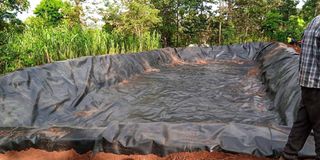The perfect way to install a dam liner

A dam with the liner put in place by Grekkon Limited.
What you need to know:
- This trench is a foot deep and a foot wide. Once the liner has been installed in the water reservoir, the outlying liner material beyond the reservoir’s edges is buried in this trench, supporting the liner in place.
- It is for this reason that in our above calculation, two metres are added to the length and width.
- Another way to support the liner is to use sand bags by placing them on this outlying liner material instead of burying it in a trench.
Most farmers wonder how to convert the measurements of a reservoir, which are in three dimensions, namely length, width and depth, to a dam liner, which is in two dimensions, that is, length and width.
The second question is how to support the dam liner in a reservoir. In this article, we answer these questions.
Calculating the dam liner area size:
Take the length and add to it double the depth and two metres.
Take the width and add to it double the depth and two metres.
Multiply the totals from (a) and (b) to get the surface area of the liner.
We multiply the depth by two to account for the entire liner base. We add two metres to cater for the liner’s tucking on the edges of the reservoir.
So, if the dimensions of your reservoir are length 20m, width 10m and depth 2m, then your liner area will be calculated as 20m (length) + 4m (double the depth) + 2m x 10m (width) + 4m (double the depth) + 2m. This is 26m by 16m = 416 metres square of liner for this reservoir size.
Supporting your liner in a reservoir
A trench is made not more than a metre away from the edge of the water reservoir all around it.
This trench is a foot deep and a foot wide. Once the liner has been installed in the water reservoir, the outlying liner material beyond the reservoir’s edges is buried in this trench, supporting the liner in place.
It is for this reason that in our above calculation, two metres are added to the length and width.
Another way to support the liner is to use sand bags by placing them on this outlying liner material instead of burying it in a trench.





